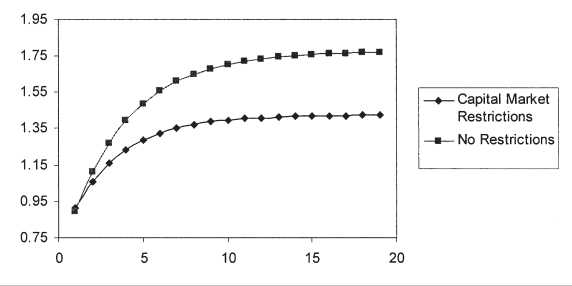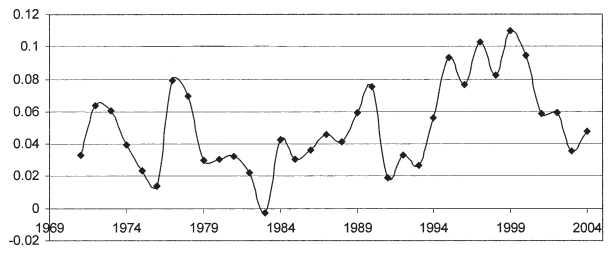258
THE ECONOMIC AND SOCIAL REVIEW
more restrictive capital markets, steady state output is significantly lower,
and the growth rate during convergence is much lower.
Figure 5: Capital-Market Openness and Growth

Quantitative Application
We now apply the model to the Irish growth experience. As is well known,
Ireland experienced a major increase in its growth rate during the 1990s.
Figure 6 displays GDP growth between 1970 and 2004. The average annual
growth rate of GDP from 1981-1990 was 3.8 per cent. In the 1991-2000 decade
this almost doubled to 7 per cent. Especially after 1995, growth rates rose
dramatically. From 2001-2004, GDP growth had returned close to the average
rates of the late 1980s.
Figure 6: GDP Growth, 1970-2004

The full accounting for the sources of Ireland’s growth success is beyond
the scope of this paper. However, the large increase in growth rates during the
1990s suggests that important structural changes took place in the late 1980s
More intriguing information
1. Social Cohesion as a Real-life Phenomenon: Exploring the Validity of the Universalist and Particularist Perspectives2. The name is absent
3. Bird’s Eye View to Indonesian Mass Conflict Revisiting the Fact of Self-Organized Criticality
4. The name is absent
5. ¿Por qué se privatizan servicios en los municipios (pequeños)? Evidencia empírica sobre residuos sólidos y agua.
6. Policy Formulation, Implementation and Feedback in EU Merger Control
7. Transport system as an element of sustainable economic growth in the tourist region
8. Developmental Robots - A New Paradigm
9. Dendritic Inhibition Enhances Neural Coding Properties
10. The name is absent